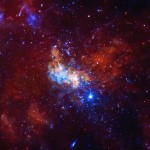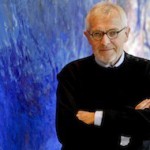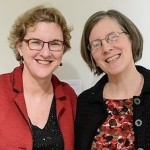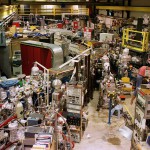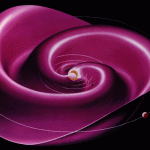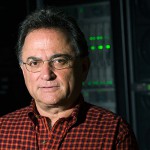Tag Physics
Telescopes hint at neutrino beacon at the heart of the Milky Way
Thanks to a confluence of data from a suite of vastly different telescopes, there are tantalizing clues that the massive black hole at the core of the Milky Way may be a cosmic accelerator. In a recent paper published in the journal Physical Review D, a team led by University of Wisconsin–Madison physicist Yang Bai reports a correlation of IceCube data with a recorded burst of X-rays from Sagittarius A, an object at the center of our galaxy that is believed to be a supermassive black hole.
UW physicist receives American Ingenuity Award for IceCube effort
Francis Halzen, the University of Wisconsin–Madison physicist who was the driving force behind the giant neutrino telescope known as IceCube at the South Pole, has been named a winner of the 2014 American Ingenuity Award.
Physicist turns smartphones into pocket cosmic ray detectors
Soon, the growing capability of your smart phone could be harnessed to detect cosmic rays in much the same way as high-end, multimillion-dollar observatories. With a simple app addition, Android phones, and likely other smartphone brands in the not-too-distant future, can be turned into detectors to capture the light particles created when cosmic rays crash into Earth’s atmosphere.
‘Cabinet of curiosities’ captures nature through work of artists and scientists
Of all the places Sierra Swenson expected to end up during her first semester at college, precious few were lined with jars full of preserved reptiles.
Advanced physics tool to shut down after almost 30 years
Faced with a federal funding shortfall, the University of Wisconsin–Madison has decided to shut down its Synchrotron Radiation Center near Stoughton on March 7.
IceCube pushes neutrinos to the forefront of astronomy
The IceCube Neutrino Observatory, a particle detector buried in the Antarctic ice, is a demonstration of the power of the human passion for discovery, where scientific ingenuity meets technological innovation.
IceCube feature film to premiere in Milwaukee planetarium show
The IceCube Neutrino Observatory is one of a kind. Built deep within the Antarctic ice, it is the world’s largest neutrino detector. Now, thanks to a collaboration between the Wisconsin IceCube Particle Astrophysics Center (WIPAC) and the Milwaukee Public Museum, it boasts another unique aspect: its own planetarium show.
The sun also flips: 11-year solar cycle wimpy, but peaking
In a 3-meter diameter hollow aluminum sphere, Cary Forest, a University of Wisconsin–Madison physics professor, is stirring and heating plasmas to 500,000 degrees Fahrenheit to experimentally mimic the magnetic field-inducing cosmic dynamos at the heart of planets, stars and other celestial bodies.
Miron Livny: Collaborative spirit supports Nobel Prize-winning science
In 1964, François Englert and Peter Higgs theorized the existence of a subatomic particle that gives all other particles mass. Nearly 50 years later in 2012, a global team of researchers found evidence that supports the existence of the Higgs boson particle at the Large Hadron Collider (LHC) in Geneva, Switzerland.
Physics Nobel awarded for Higgs particle; UW played key role in research
UW–Madison teams led by physicists Sau Lan Wu and Wesley Smith have played crucial roles in the development and operation of the two main experiments at the Large Hadron Collider (LHC) that discovered the Higgs boson in July 2012.
Colleagues remember Rader for technical skills, human touch
Computing can be a complex and difficult topic for those without technical experience. Stephen Rader’s easy-going manner made his colleagues in the Physics Department feel at-ease with technology and helped support their research successes.
Unique engineering shop looks to another challenge of 21st century physics
Sequestered in the farmland near Stoughton, an unusual University of Wisconsin–Madison facility - part machine shop, part design lab, part physics outpost - continues to make machines, equipment and detectors for the world's most advanced experiments.
Vaterite: Crystal within a crystal helps resolve an old puzzle
With the help of a solitary sea squirt, scientists have resolved the longstanding puzzle of the crystal structure of vaterite, an enigmatic geologic mineral and biomineral.
Physics Fair at UW–Madison this Saturday
The sixth annual UW–Madison Physics Fair will offer physical delights and pain-free education free to all comers on Saturday, Feb. 16 on the UW–Madison campus.
UW–Madison physicist wins science image challenge
Close your eyes and picture an ocean reef: vivid violet, cool blue and tropical green intertwining in gentle curves and delicate edges. And that's just the urchin teeth.
One step closer: UW–Madison scientists help explain scarcity of anti-matter
A collaboration with major participation by physicists at the University of Wisconsin–Madison has made a precise measurement of elusive, nearly massless particles, and obtained a crucial hint as to why the universe is dominated by matter, not by its close relative, anti-matter.
With new high-tech materials, UW–Madison researchers aim to catalyze U.S. manufacturing future
Drawing on methods similar to those used to sequence the human genome, a multi-university team of researchers aims to discover and create revolutionary advanced materials that could help solve grand challenges in such areas as energy, national security and human health.
Scientists begin effort to stir up a cosmic dynamo in the lab
For scientists trying to understand the subtleties of cosmic dynamos - the magnetic field-inducing phenomena at the hearts of planets, stars and galaxies - the physics, for the most part, must be done at vast distances.
Physicist to chair European scientific board
Baha Balantekin, Eugene P. Wigner Professor of Physics, has been elected chair of the Scientific Advisory Board for the European Centre for Theoretical Nuclear Physics and Related Areas at Trento, Italy.
Hydrogen beam injector guides plasma physics research
The Madison Symmetric Torus, a leading piece of equipment in plasma physics research for more than 20 years, recently gained a new capability with the installation of a neutral beam injector.

